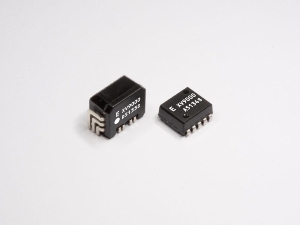Sep 10 2010
Epson Toyocom Corporation's U.S.-based Timing Products Division today announced a new series of compact, reliable gyro-sensors (angular rate sensors) designed for increased vehicle safety and to meet upcoming legislated electronic stability control (ESC) requirements in the global automotive industry.
Utilizing Epson Toyocom's original packaging technology, the new XV-9000 series is also capable of withstanding temperatures as high as 125°C. Product samples are available now with volume production scheduled for December 2011.
 By applying Epson Toyocom's QMEMS technology to fabricate crystal sensing elements in an original hammerhead structure, a series of very small sensors was created that exhibit stable characteristics over a wide temperature range (-40 to +125°C).
By applying Epson Toyocom's QMEMS technology to fabricate crystal sensing elements in an original hammerhead structure, a series of very small sensors was created that exhibit stable characteristics over a wide temperature range (-40 to +125°C).
As calls for safer vehicles grow louder, the United States, Europe, and Japan have all introduced legislation mandating that vehicles be equipped with active safety systems such as ESC devices to detect skidding and to correct vehicle attitude. The new XV-9000 series is the latest and most advanced of these gyro-sensor systems designed to detect changes in attitude by measuring angular velocity. The units are also equipped with circuits that provide critical self-diagnosis capabilities for today's most reliable operation.
By applying Epson Toyocom's QMEMS technology to fabricate crystal sensing elements in an original hammerhead structure, a series of very small sensors was created that exhibit stable characteristics over a wide temperature range (-40 to +125°C). In addition, sensor reliability was further increased by providing a diagnostic circuit that detects failures at any given time during operation and at startup. The sensors have also achieved excellent vibration resistance and shock survivability by optimizing the sensing elements and their support structure.
The XV-9000 series consists of four types of sensors, including two types of yaw rate sensors (the XV-9100LV and XV-9100LP), which have a sensing range of +/-100 deg/s, and two types of roll rate sensors (the XV-9300LV and XV-9300LP), which have a sensing range of +/-300 deg/s. The board on which the sensors are packaged, as well as the sensing axes, account for the differences among the sensor types. The "LP" packages are for sensing in the planar direction, while the "LV" packages are for sensing in the vertical direction.
The new XV-9000 series is another example of Epson Toyocom's commitment to contribute to greater traffic safety by providing stable, reliable angular rate sensors for automotive applications.
Source: http://www.epsontoyocom.co.jp/